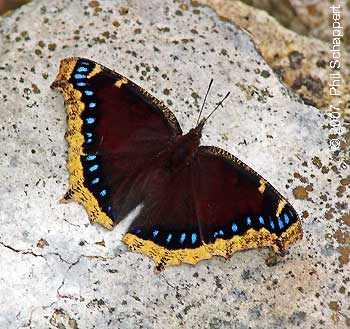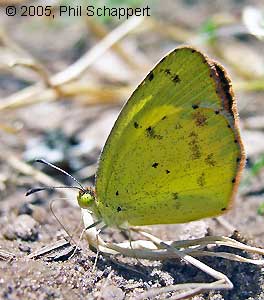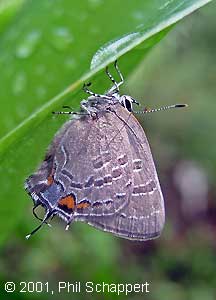 Articles...
Articles... 
Turn Your Yard into a Butterfly Sanctuary
© 2003, Phil Schappert
Authors note: The article below is one that I wrote for the Brooklyn Botanical Garden's "All-Region Guides" series. It was published in The Butterfly Gardener's Guide (BBG Handbook #175; pp. 35-40), which was edited by Claire Hagen Dole, in 2003. The photographs used here, however, are all my own.
 Butterflies and other insects have two things going for them that most other conservation targets don't: they're relatively short-lived, and they're quite small. As with most other insects, butterflies have short generation times, and many species have multiple generations in a year or season. What we do to their habitat right now often has a direct impact on their lives.
Butterflies and other insects have two things going for them that most other conservation targets don't: they're relatively short-lived, and they're quite small. As with most other insects, butterflies have short generation times, and many species have multiple generations in a year or season. What we do to their habitat right now often has a direct impact on their lives.
And while it's true that some insects have large home ranges and others travel long distances, many spend their entire lives in areas not much larger than most backyards. The implications for butterfly conservation are pretty simple: if you plan and implement a butterfly garden with these thoughts in mind, you can provide an oasis of habitat that can sustain the entire life history of some butterflies.
Even simple, small changes can have pretty large impacts on the lives of the butterflies that frequent your garden. Think of your butterfly garden as a miniature wildlife preserve—even better, think of your yard as one in a chain of similar backyard sanctuaries—and you'll be well on your way to helping butterfly and other insect populations to not only persist in largely urban environments but to thrive.
Fulfilling the Needs of Butterflies
Look at your neighbourhood from a butterfly's perspective: consider how far butterflies have to fly to find all of the resources they need to live. How far will they have to travel if they can't find all that they need in your backyard garden? If your neighbours also garden for wildlife, then you are well on your way to establishing a small network of butterfly habitats that can complement each other. Adjacent gardens provide corridors along which butterflies can move. The shorter its flights, the more likely it is that a butterfly will succeed in getting what it needs without falling prey to predators.
The way to turn your butterfly garden into a backyard sanctuary is to provide the necessary resources for all of a butterfly's life stages. Here are a few tips to help you create a butterfly-friendly environment...
 Choose caterpillar food plants as well as nectar plants. One of the most important considerations is to make sure that, in addition to nectar-rich flowers, you include caterpillar host plants to give female butterflies places to lay their eggs and provide food for their caterpillars. Host plants don't only help keep female butterflies around your garden, they also help attract males looking for females.
Choose caterpillar food plants as well as nectar plants. One of the most important considerations is to make sure that, in addition to nectar-rich flowers, you include caterpillar host plants to give female butterflies places to lay their eggs and provide food for their caterpillars. Host plants don't only help keep female butterflies around your garden, they also help attract males looking for females.
It is unfortunate that too many gardeners consider caterpillars as pests, but I think—though I might be considered biased—that caterpillars are the most interesting part of a butterfly's life cycle. Of course, many gardeners fail to realize that where there are host plants and caterpillars, you can be sure that pupae will be found nearby and that there will eventually be even more butterflies.
 Give preference to native plants and wildflowers. The local butterflies that you are trying to attract to your garden have a history with the local plants. Given a choice between unknown, foreigh plant species and locally native species, the butterflies will most likely prefer natives as hosts. Native plants also provide a sense of place to your yard and to the community, don't make the mistake of trying to have a Miami garden in Tucson: you'll spend way too much time gardening and not enough time enjoying your garden!
Give preference to native plants and wildflowers. The local butterflies that you are trying to attract to your garden have a history with the local plants. Given a choice between unknown, foreigh plant species and locally native species, the butterflies will most likely prefer natives as hosts. Native plants also provide a sense of place to your yard and to the community, don't make the mistake of trying to have a Miami garden in Tucson: you'll spend way too much time gardening and not enough time enjoying your garden!
Arrange plants thoughtfully. Most butterfly habitats are three-dimensional, that is they include several layers with a variety of plants at differing heights. To emulate nature's multilayered approach you should include plants that bloom at different heights, as well as small flowering shrubs that offer twigs to perch on. Consider adding a few vines to your plant choices since these often bloom at various heights. Masses of blooms, or the close proximity of caterpillar host plants, are more attractive to butterflies than widely-spaced plants, so give some thought to mass plantings of particularly attracive species.
Pick plants for every season. Attract adult butterflies with colourful flowers that offer nectar from spring through fall, or choose a variety of different plants that bloom at different times of the season to achieve the same effect. It's also useful to provide a range of suitable host plants for multi-brooded species. For example, provide Monarchs with early-blooming milkweeds that may die back part way through the summer as well as late-blooming species that provide suitable egg-laying sites later in the season.
 Create a sunny corner. Butterflies need some open, sunny spaces, out of the wind, where they can bask. Their bodies depend on the temperature of the air around them so they often need sunshine to warm them up to flight temperature. Consider not covering every square inch of your garden with plants but instead leave a protected sunny corner, or even a centrally-located spot with a few paving stones, as a butterfly sunning area.
Create a sunny corner. Butterflies need some open, sunny spaces, out of the wind, where they can bask. Their bodies depend on the temperature of the air around them so they often need sunshine to warm them up to flight temperature. Consider not covering every square inch of your garden with plants but instead leave a protected sunny corner, or even a centrally-located spot with a few paving stones, as a butterfly sunning area.
Provide shelter and perches. Butterflies also need sheltered areas to escape strong winds and rain. Unfortunately, so called "butterfly houses" rarely achieve their goal (although they do make good refuges for predators like spiders and wasps, which help in the biological control of garden pests). Instead, a border of shrubs and trees can provide host plants for caterpillars, as well as dry places where butterflies can hide from bad weather or predators. Untended edges of grasses, clovers, and dandelions also provide shelter and early nectar for certain species. Some butterflies also require perches where they can watch for mates so tall herbs or small flowering shrubs can serve a dual purpose.
 Set up a spot for puddling. In addition to the nectar they get from plants, most species need to acquire compounds that they cannot get from plants. Many of these are mineral salts that are naturally available in the soil of your garden. An empty sandy spot under a bird bath or dripper, where the soil is often wet, is the perfect spot for butterflies to gather on the ground and get the additional nutrients they need.
Set up a spot for puddling. In addition to the nectar they get from plants, most species need to acquire compounds that they cannot get from plants. Many of these are mineral salts that are naturally available in the soil of your garden. An empty sandy spot under a bird bath or dripper, where the soil is often wet, is the perfect spot for butterflies to gather on the ground and get the additional nutrients they need.
Relax your neat and tidy standards. A garden that looks and acts more like nature is not only easier on the person maintaining it but also allows habitat to develop for butterflies at all four life stages. Leave a corner of your yard untended, allowing native grasses to grow and feed caterpillars of skippers and satyrs. Don't remove clovers, they provide early and late nectar to a variety of insects and are larval host plants for sulphurs, blues, and skippers. In autumn, let fallen leaves create a natural mulch—where moths and skippers pupate—before the leaf litter decomposes into nutrients for your garden.
Lose the lawn. Plan to reduce or elimate lawn, which offers nothing to wildlife, wastes precious water, and is a major source of pesticide and herbicide contamination of our waterways and lakes.
Hold the poisons. One caveat that should be readily appreciated by anyone with a wildlife garden is that the use of pesticides—even so-called biological control agens such as Bt (Bacillus thuringiensis), which kills all caterpillars indiscriminately—should be strictly controlled or, even better, avoided altogether. Stick with natural products such as insecticidal soaps or plant-derived oils for those rare occasions when pest control is needed. I rarely use even natural pesticides in my garden, preferring to let nature take its own course—which, in my case, includes letting lizards, spiders, wasp, ants, and other insect predators do the dirty work for me. My way of thinking is, why should I pay for what nature will do free of charge?
Looking Beyond Your Butterfly Sanctuary
 If butterflies are worth attracting to your garden, aren't they also worth having in local parks, public gardens, and natural areas? And to ensure that there are butterflies available to come to your garden, don't you also need to help protect them everywhere?
If butterflies are worth attracting to your garden, aren't they also worth having in local parks, public gardens, and natural areas? And to ensure that there are butterflies available to come to your garden, don't you also need to help protect them everywhere?
My best advice is to be proactive rather than reactive. Don't wait for butterflies to become endangered, but work now to help keep them safe. For example, ask local or regional agencies to cease, or at least limit, roadisde pesticide spraying; ask them to ensure that roadside mowing is rotated through the seasons instead of always being done at the same time in the same place each year; and to use native plants wherever possible. Any of these initiatives that you can conduct on a wide scale will help you have butterflies always—the flying flowers of the insect world—in your own backyard sanctuary to watch and enjoy.


